Festivals
 GODDESS TEMPLE FESTIVAL
GODDESS TEMPLE FESTIVAL

hình này đẹp nên giữ lại, chỉ thêm text GODDESS TEMPLE FESTIVAL

 Tet Nguyen Dan (or The Lunar New Year)
Tet Nguyen Dan (or The Lunar New Year)
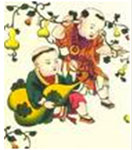 This is the most important festival of the year for Vietnam's Kinh ethnic majority. From the first days of the lunar year, everyone strives to plan the perfect Tet by erecting "cay neu" (the Tet pole) 5 to 6 metres high in front of their house, making "banh chung" (a square cake made of sticky rice stuffed with beans and pork), redecorating their homes, painting the foot of trees with white lime powder or painting the pictures of a bow and arrow on the walls to wipe out ghosts and devils.
This is the most important festival of the year for Vietnam's Kinh ethnic majority. From the first days of the lunar year, everyone strives to plan the perfect Tet by erecting "cay neu" (the Tet pole) 5 to 6 metres high in front of their house, making "banh chung" (a square cake made of sticky rice stuffed with beans and pork), redecorating their homes, painting the foot of trees with white lime powder or painting the pictures of a bow and arrow on the walls to wipe out ghosts and devils.
Tet means saying goodbye to the previous year and starting
a new year. So at midnight on New Year's Eve, a ceremony
called "Giao Thua" is held in which a sacrifice
for the spirits and the ancestors is made on a lovely candle-lit
altar in the open air near the home. In the old times people
had many activities to offer each other New Year wishes.
Source: Hanoi administration tourism

 Duong Vuong Temple Festival
Duong Vuong Temple Festival
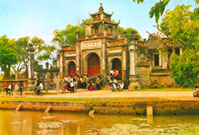 An Duong Vuong Temple is located in Co Loa village, Dong Anh district, Hanoi. It is on the way to Phuc Yen and about 17 km from the center of Hanoi.
An Duong Vuong Temple is located in Co Loa village, Dong Anh district, Hanoi. It is on the way to Phuc Yen and about 17 km from the center of Hanoi.
Located on this land is Ngu Trieu Di Quy communal house which is believed to be where the Thuc King held Court. Am Ba Chua is where people worshiped the lovely daughter of the Thuc King, princess My Chau. We can now see a headless statue there, which is a vestige of the country lost by My Chau. She was so honest and credulous that she was trapped in a scheme by the enemy.
On the 6th day of the first lunar month every year, people
from 12 hamlets of Co Loa commune organize a festival called
An Duong Vuong Temple Festival which lasts for 10 days.
Source: Hanoi administration tourism

 Ba Den Mountian Vietnam Festival, Tay Ninh Festivals
Ba Den Mountian Vietnam Festival, Tay Ninh Festivals
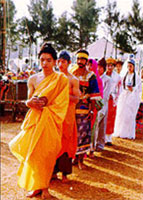 One cannot visit Vietnam’s Tay Ninh without going to Nui Ba, a beautiful high mountain located in the middle of the MeKong Delta, 11km from Tay Ninh. Nui Ba Mountain is often called Ba Den. Mountain after the devoted daughter of a Vietnamese guard officer. She left her father's house and went to the mountain to become a monk after she was forced to marry a guard officer's son.
One cannot visit Vietnam’s Tay Ninh without going to Nui Ba, a beautiful high mountain located in the middle of the MeKong Delta, 11km from Tay Ninh. Nui Ba Mountain is often called Ba Den. Mountain after the devoted daughter of a Vietnamese guard officer. She left her father's house and went to the mountain to become a monk after she was forced to marry a guard officer's son.
She later died in Nui Ba. The Nguyen dynasty had a bronze statue made in her honor and gave her the title Linh Son Thanh Mau, or Saint Linh Son.
On the afternoon of the 30th of the last lunar month until the 2nd lunar month, tourists from Ho Chi Minh City and other southern provinces go on a pilgrimage to the Ba Den Mountain.
Pilgrims and visitors have to climb halfway up of the
mountain to enter Saint Linh Son Temple. This pagoda offers
vegetarian meals in exchange for which visitors can make
a donation to the pagoda. Visitors can also stay in the
pagoda for a few days. The monks are well known for taking
excellent care of their visitors. Visitors to this Vietnam
landmark can also climb up to the top of the mountain, where
a Saint Temple is located. During Spring, people from Vietnam's
southern provinces visit this temple as a ritual; everyone
believes that Ba Den Temple can fulfill the intellectual
needs of spiritual people.
Source: Vietnam Paradise Travel

 Legends of Huong River, the most-splendid-ever festivity on the river
Legends of Huong River, the most-splendid-ever festivity on the river
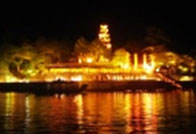 As a mild rhythm in the gorgeous symphony of Truong Son range, Huong River has become a special gem of this land. It is this river that embraces and shapes Hue, breeding the birth and the development of Thuan Hoa town, or Phu Xuan town later, and then Hue Old Capital, for over 700 years now.
As a mild rhythm in the gorgeous symphony of Truong Son range, Huong River has become a special gem of this land. It is this river that embraces and shapes Hue, breeding the birth and the development of Thuan Hoa town, or Phu Xuan town later, and then Hue Old Capital, for over 700 years now.
Especially, the river is embedded with numerous legends, ranging from that of its name to those of other historical figures. This is the source of inspiration for the festive program “Legends of Huong River” in Hue Festival 2008.
The program “Legends of Huong River” is scened from Bang Lang cross-river to Nghinh Luong Dinh, and composed of two sub-programmes: on boat (moving) and on-site (without moving).
The program is to highlight the culture, history and natural landscape beauty of a river that has been close to the heart of Hue people; honor the tangible and intangible cultural values of Hue as an old capital. It is an attractive tourism product that will be provided regularly, thus helping to raise the profile of Hue as a land of rich culture and tourism; and enriching the cultural life of people.
Together with a major Royal boat, 20 other dragon boats
will team up into a boat leasure procession by a king of
the Nguyen Dynasty. Major Royal boat is a spacy one (around
7m x 18m), restored and adjusted to accommodate about 50-60
tourists/voyage. There is a screen on the boat to display
power-point presentations about the river.
Source: Hue Festival Center

 Thay Pagoda Festival
Thay Pagoda Festival
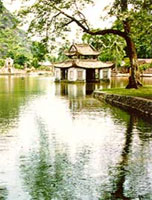 Thay village (nowadays called Thuy Khe village) is located at the foot of Sai Son mountain in Quoc Oai district, Ha Tay province. Visitors come to this village all year round for several reasons.
Thay village (nowadays called Thuy Khe village) is located at the foot of Sai Son mountain in Quoc Oai district, Ha Tay province. Visitors come to this village all year round for several reasons.
The village and Sai Son mountain provide well-known scenic spots including the pleasant Long Tri Lake (Dragon Lake). This lake has a big house called Thuy Dinh (Water Temple) for viewing yearly water puppets shows in the middle of it two wooden bridges with curved tiled roofs and many beautiful mountain caves.
The mountain also has, at its foot and on its slopes, a number of old pagodas, the most well known of which is the Thay Pagoda where people worship Tu Dao Hanh, a monk of the Ly Dynasty who hailed from Lang village (Hanoi) and was endowed with supernatural powers.
Both the Thay and Lang Pagodas festivals are held in early
March of each year, but differ from each other in terms
of specific rites and ceremonies. The Thay Pagoda festival
is actually a joint festival of four villages (Thuy Khe,
Da Phuc, Khanh Tan and Sai Khe). Though the whole area has
many pagodas, the festival is held mainly in Thay Pagoda,
which comprises three buildings: ante-chamber, Buddha's
Building and Building of the Genius.

 The Gong Performance Festival of the Muong Ethnic People
The Gong Performance Festival of the Muong Ethnic People
 When mentioning art performance, production and cultural life of the Muong people, it is impossible to forget to mention the Gong, which is a kind of musical instrument reflecting cultural features and life conception of the Muong ethnic minority group.
When mentioning art performance, production and cultural life of the Muong people, it is impossible to forget to mention the Gong, which is a kind of musical instrument reflecting cultural features and life conception of the Muong ethnic minority group.
The Muong people have to exchange buffalo or cow to have the Gong. The Gong is the most valuable dowry that parents give to their daughter on her wedding day.
The Muong people use the Gong on such days as Tet (the lunar New Year’s days), wedding, funeral, the inauguration ceremony of new house, festivals, etc
Annually, the Department of Culture and Information of
Phu Tho organizes the Gong performance festival over the
province. The festival is the chance for the Gong players’
teams of mountainous villages to give a common cultural
character. Muong’s girls wearing their costume clothing
beating the Gong and dancing around the fire have become
one of the most special character of the Muong’s culture
in particular and the Vietnamese culture in general.
Source: PT Trade & Tourism

 Dancing Festival of Dao Ethnic People
Dancing Festival of Dao Ethnic People
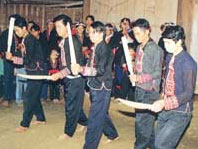 The religious life of the Dao ethnic people has various practices like the worshiping of the ancestor of the Dao ethnic people called Ban Vuong worshiping, the festival on creating names for men and dancing festival. The Dao ethnic people in Phu Tho consider the festival as the God, Buddha and Genie thanking festival.
The religious life of the Dao ethnic people has various practices like the worshiping of the ancestor of the Dao ethnic people called Ban Vuong worshiping, the festival on creating names for men and dancing festival. The Dao ethnic people in Phu Tho consider the festival as the God, Buddha and Genie thanking festival.
Dancing festival is different in the Dao Tien and the
Dao Quan Chet. The Dao Tien people organize the festival
from the fifteenth to the twenty seventh of the 12th lunar
month. In preparations for the dancing festival, the host
has to ask for a favor from villagers, who help him prepare
drum and gong, whittle knife-shaped lance, sword and review
folk songs. During the festival, total 120 turns of dances
are performed. The festival is the great cultural life guiding
human to kindness, linking people and making them happy
and believe in the life in the future.
Source: PTO

 Trieu Khuc Festival
Trieu Khuc Festival
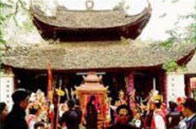 Trieu Khuc village or Ke Do village is located in Tan Trieu commune, Thanh Tri district.
Trieu Khuc village or Ke Do village is located in Tan Trieu commune, Thanh Tri district.
In the past Ke Do was famous for nón quai thao (a kind of hat for women). Today it is famous for embroidery and objects of worship, such as parasols and curtains which were invented by Lord Vu. Every year, villagers organise a festival to honour Lord Vu and a martial arts event depicting the King Phung Hung's battle.
Trieu Khuc festival runs from the 9th to the 12th day of the first lunar month in Dinh Lon.
The Trieu Khuc wrestling arena attracts a lot of wrestlers from nearby areas such as Bac Ninh, Gia Lam, Mai Dong and so on. The dragon dance in Trieu Khuc festival is authentic with traditional characteristics because it is said to originate from the King Phung Hung's period. Thus, every year they invite the Trieu Khuc's dragon dancers to perform in the Dong Da Festival.
The 12th day of first lunar month is the final day of
the festival. On this day, a final
ceremony is held and concluded by a procession of the flag
dance. This dance depicts the legend, according to which
the King Phung Hung selected the best person to drive out
the enemy. At the end of the official ceremony, people sit
down on the mats and eat the God's
food and fruit drink wine and eat "trau" (betel).
The celebration is very joyful and villagers pray for health,
prosperity and a bumper harvest.
Source: hanoitourism.gov.vn

 Elephant Race Festival, Dak Lak Festivals
Elephant Race Festival, Dak Lak Festivals
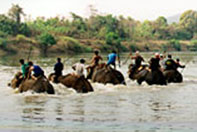 The
Elephant Race Festival takes place in springtime, normally
in the third lunar month. In preparation for the festive
day, people take their elephants to places where they can
eat their fill. Apart from grass their food also includes
bananas, papayas, sugar canes, corns, sweet potatoes.
The
Elephant Race Festival takes place in springtime, normally
in the third lunar month. In preparation for the festive
day, people take their elephants to places where they can
eat their fill. Apart from grass their food also includes
bananas, papayas, sugar canes, corns, sweet potatoes.
The elephants are free from hard work to preserve their
strength.
On the big day, elephants from different villages gather
at Don Village. People from near and far in their best and
colourful costumes flock to the festival. The racing ground
is 500m long and wide enough for ten elephants to stand
simultaneously.
After a salvo of tu va (horns made into musical instruments),
the elephant handlers called nai take their elephants to
the ground, standing in a row at the starting point. The
leading elephant stands in front, whirling his trunk and
nodding his head in greeting the spectators. Atop each elephant
there are two handlers in traditional costumes for generals.
The tu va signals the start of the race and the elephants
rush forwards amidst the resounding cry of the spectators.
The first handler uses an iron stick called kreo in M'Nong
language to speed the elephant. The second handler beats
the elephant with a wooden hammer called koc to ensure its
speed and to keep it in the right line. Upon seeing the
first elephant dashing to the destination the spectators
shout boisterously amidst the echoing sound of drums and
gongs.
The winning elephant is given a laurel wreath. Like its
owner, the elephant expresses its happiness and enjoy the
sugar canes and bananas from the festivalgoers.
Source: Vietnam Paradise Travel

 The Yen Tu pagoda festival
The Yen Tu pagoda festival
 The Yen Tu Pagoda festival takes place from Jan 15 to Mar 15 (lunar year) in Quang Ninh, a border province. Yen Tu is the name of a 1,068m high mountain, some 15 km to the North West of Uong Bi, chief town of Quang Ninh province.
The Yen Tu Pagoda festival takes place from Jan 15 to Mar 15 (lunar year) in Quang Ninh, a border province. Yen Tu is the name of a 1,068m high mountain, some 15 km to the North West of Uong Bi, chief town of Quang Ninh province.
As is well-known, it was the birth place of Truc Lam, a Buddhist sect founded by Vietnam'ss King Tran Nhan Tong (1258-1308). Yen Tu has a beautiful scenery but is very difficult to access, with a myriad of brooks, steep slopes, deep abysses, and small winding lanes leading, through forest of fir trees, to its cloudy top.
The first scenic spot one comes across is the Suoi Tam brook, where King Tran Nhan Tong, on the way to Yen Tu mountain from the Capital, had to stop and take a bath in order to get rid of all the dust of the world of human beings.
Not far from Suoi Tam, is the Cam Thuc Pagoda where the King had his first vegetarian meal, consisting of plain rice cooked with the water in the brook and vegetables gathered on the spot.
Going further, one sees the ruins of the Lan Pagoda with,
among other things, a dozen stupas and some stelae. After
crossing the Elephant Pass, one reaches the "Clearing
Unjust Charges" Pagoda, located near a brook bearing
the same name.
Source: vnstyle

 Dong Ky Festival
Dong Ky Festival
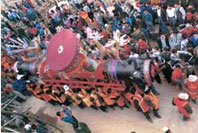 Dong Ky village belongs to Dong Quang commune, Tu Son district, Bac Ninh province. Every year, on the 4th day of the 1st lunar month, Dong Ky village holds a firecracker festival.
Dong Ky village belongs to Dong Quang commune, Tu Son district, Bac Ninh province. Every year, on the 4th day of the 1st lunar month, Dong Ky village holds a firecracker festival.
Legend has it that during the reign of the 6th Hung King (BC), Thien Cuong, a villager of Dong Ky, joined the army to repel the An invaders. As Thien Cuong fought bravely and achieved many feats, the Hung King gave him the title of Thien Cuong Lord, and the Dong Ky village started worshipping him.
Burning firecrackers to welcome Thien Cuong, the returning
hero, became part of the legend and the basis of the Dong
Ky Firecracker festival. To prepare for the festival, a
number of families in the village are selected, prior to
the Lunar New Year, to produce the firecrackers. On the
4th day of the first lunar month starts the procession ceremony
of firecrackers. In the front ranks of the procession are
the festival banners, the musical company and various kinds
of palanquins and articles of worship. Then come the 10
selected families with their firecrackers and food offerings.
Each family is represented by its 16 young members who carry
a big firecracker or a tray of smaller firecrackers. As
they walk, the young men shout slogans to honour Hero Thien
Cuong and hold up the trays of firecrackers over their heads.
Source: vnstyle

 Hai Ba Trung (Trung sisters) Festival
Hai Ba Trung (Trung sisters) Festival
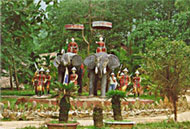 Hai Ba Trung Temple is located 500 kilometres from Nguyen Cong Tru street, in Dong Nhan commune. This temple was erected in dedication to the two Trung sisters - Trung Trac and Trung Nhi, the first two heroines of the country.
Hai Ba Trung Temple is located 500 kilometres from Nguyen Cong Tru street, in Dong Nhan commune. This temple was erected in dedication to the two Trung sisters - Trung Trac and Trung Nhi, the first two heroines of the country.
Hai Ba Trung's heroic uprising against the ruling Chinese lasted 3 years and was defeated. However this uprising is an event of great significance as it left a bright example to later generations. People built many temples to honour them, the most famous are three temples, Hat Mon Temple (in Ha Tay province), Ha Loi Temple (in Vinh Phuc province), and Dong Nhan Temple (in Ha Noi).
Hai Ba Trung Festival runs from February the 3rd to the
6th day of the lunar calendar. On the 3rd day, it starts
with the ritual ceremony of opening the temple's door. In
the morning of the 4th day, people begin the funeral ceremony. The 5th day is the main day
of the festival. During this day, it holds a statue-bathing ceremony, woman-officer
worshipping ceremony and a candlelight dance. On the 6th
day is the vegetarian diet ceremony.
According to ancient practices, a ritual worshipping ceremony
is performed by elderly women. The statue-bathing ceremony
is the most important. In the early morning, a procession
involving lacquered and gilded palanquins carried by young
men and escorted by older men with music
band, solemnly proceeds from the temple to the Red River.
Source: Hanoi Administration Tourism

 Muslim Cham ethnic people hold Ramuvan Festival
Muslim Cham ethnic people hold Ramuvan Festival
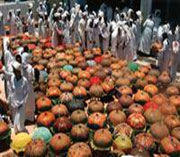 The
Muslim Cham ethnic people in southern coastal Ninh Thuan
province celebrate their traditional Ramuvan Festival, which
began on August 29.
The
Muslim Cham ethnic people in southern coastal Ninh Thuan
province celebrate their traditional Ramuvan Festival, which
began on August 29.
On the occasion, the provincial authorities have visited
and presented gifts to the community’s dignitaries and individuals
who had made great contributions to the local socio-economic
development.
During the three-day festival, which is the most important
annual celebration of the Muslim Cham people in the province,
people hold banquets and feasts and spend time repairing
houses.
There are almost 67,650 Cham ethnic minority people in the
province, accounting for 11.69 per cent of the population.
Of them, 30,495 are Muslims and the remainder, Hinduism
followers.
Source:www.saigon-gpdaily.com.vn

 Tao Dan Park Hosts Ornamental Creature Festival
Tao Dan Park Hosts Ornamental Creature Festival
 The third Ornamental Creature Festival will be held at the Tao Dan Cultural Park in District 1 from Aug. 30 to Sept. 7 to celebrate National Day (Sept. 2).
The third Ornamental Creature Festival will be held at the Tao Dan Cultural Park in District 1 from Aug. 30 to Sept. 7 to celebrate National Day (Sept. 2).
There will be nearly 200 display booths of gardeners, organizations and enterprises from Ho Chi Minh City and from the provinces.
Malaysia’s Association of Ornamental Fish will send pet fish to the contest and present ornamental creature services at the festival, he added.
There were many activities during the festival, including exhibits of rare ornamental trees as well as contests of dogs, pet fish, bonsai, and ancient ornamental trees.
There will also be seminars on crop plants, cultivation
techniques, orchids, birds, and pet dogs with the participation
of experts. The city authorities will award the title “Ornamental
Creature Artisan” to 29 artists on August 31.
The festival offers visitors a chance to buy products from
well-known farms, handicraft villages and farmers’ associations.
It will be also the country’s largest event of its type
and a good opportunity for enterprises to introduce their
products, exchange experiences and boost sales.
The annual show is organized by the HCMC Ornamental Creature
Association and HCMC Farmers' Association.
Source:www.saigon-gpdaily.com.vn

 Tay Son – Binh Dinh Festival Opens
Tay Son – Binh Dinh Festival Opens
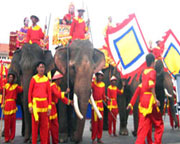 The Tay Son – Binh Dinh festival opened with a reenactment of a procession of Emperor Quang Trung and his civil and military mandarins in Phu Phong Town, Tay Son District .
The Tay Son – Binh Dinh festival opened with a reenactment of a procession of Emperor Quang Trung and his civil and military mandarins in Phu Phong Town, Tay Son District .
The march included cavalry, infantry, female general Bui Thi Xuan, imperial commander-in-chief Tran Quang Dieu, and Emperor Quang Trung. The festival uses the theme “Converging and Development” and is being held on August 1-3.
Stories of the glorious feats of arms of national hero
Quang Trung (Nguyen Hue) and the legendary Tay Son army
spread throughout Viet Nam over 200 years ago. They struggled
for independence, defending the country from invaders, and
uniting the country.
Source:www.saigon-gpdaily.com.vn

 Binh Dinh Hosts Traditional Tuong Festival
Binh Dinh Hosts Traditional Tuong Festival
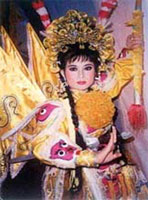 A festival featuring Vietnamese classical opera, or tuong, or will be held for the first time in Qui Nhon City in the central province of Binh Dinh July 25-30.
A festival featuring Vietnamese classical opera, or tuong, or will be held for the first time in Qui Nhon City in the central province of Binh Dinh July 25-30.
There are seven theaters taking part in the festival: HCMC Hat Boi (or tuong) Art Theater, Viet Nam National Tuong Theater, Nguyen Hien Dinh Theater, Dao Tan Theater, Khanh Hoa Traditional Art Theater, Hue Royal Traditional Art Theater and Thanh Hoa Tuong Theater.
The event is organized by the Performing Arts Department of the Ministry of Culture, Sport and Tourism, by Viet Nam Stage Artist Association and by Binh Dinh province.
The festival will be held as part of the Tay Son – Binh
Dinh festival, which will take place August 1-3. This festival
will include various activities such as offering incense,
lantern night, poetry recital, a Miss Martial Arts festival
and a traditional martial arts festival.
Source:www.saigon-gpdaily.com.vn



